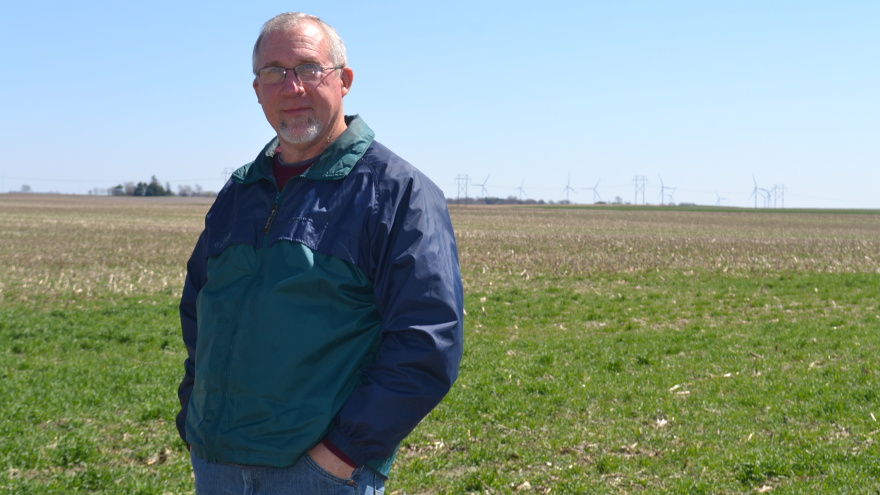This story was produced in partnership with the Food & Environment Reporting Network
Climate change is not a big concern for Lin Warfel. Sure, he’s noticed the increasing rainfall over the 60 odd years he’s been farming corn and soybeans in central Illinois — especially when ponds form in his soybean fields. But he’s pretty sure there’s nothing he can do about it.

And yet, over the past few years, Warfel has gradually started incorporating climate-change fighting techniques on his farm. He plants cover crops on some of his land in the winter time, which sequester carbon from the atmosphere. He’s stopped tilling, or plowing, his soil as much, which helps keep carbon in the ground.
To implement this new style of farming, Warfel had help from a program called STAR — Saving Tomorrow’s Agriculture Resources. STAR encourages farmers to implement sustainable practices on their farms, and in the process, is making farms across the Midwest more climate-friendly. And yet, the words “climate change” are nowhere to be found in the program’s objectives.
“We don’t use the words climate change,” said Steve Stierwalt, an Illinois-based farmer and co-founder of STAR. “In the agricultural community that becomes a political term.”
Rather, the program draws on another environmental issue that is much more front of mind for farmers: soil erosion.
Unlike climate change, soil erosion is a huge concern for Illinois farmer Lin Warfel. He’s the fourth generation to farm the land his great-grandparents bought in the mid-1800s. And throughout his lifetime, he’s watched a lot of soil disappear.
“All of a sudden, a whole bunch of the soil would be gone. There would be a ravine there … where I used to have soil,” he said. “That was a big problem.”
Maintaining a healthy bed of topsoil — the top foot or so of soil — is essential for farmers to grow their crops. And yet, Midwestern farmers have lost about one-third of their topsoil since Europeans first settled in the region.
That’s largely due to an overall decline in soil health caused by conventional farming methods. Heavy tilling, which involves stirring up the soil in order to prepare it for planting, also loosens it up, priming it for erosion. Soil is also often left bare in between harvest and planting seasons, which leaves it vulnerable to erosion. Erosion is also exacerbated by intensifying wind and rain storms caused by climate change.
It’s an urgent issue for farmers, and some — like the founders of STAR — are mobilizing to fight it.
“Soil is a finite resource, you know, and we've already lost half our organic matter here in east central Illinois,” said Joe Rothermel, farmer and co-founder of STAR.
Rothermel and Stierwalt are on the board of their local Soil and Water Conservation District. Around 2017, STAR was born out of conversations between the two on how to better conserve soil in their district. They decided to start a program in which farmers submit their conservation practices and get rated — between 1-5 stars — for how well they’re doing at preserving soil.
“So many people understand rating things by stars,” said Stierwalt. “You may have been to a restaurant and checked to see what the star rankings of it are before you go.”
The climate connection
The agriculture industry accounts for 10% of U.S. greenhouse gas emissions. In order to reduce those emissions, conventional agriculture will have to transform.
STAR is making that happen. The program encourages a less conventional style of farming, which is necessary to fight soil erosion. And, serendipitously, almost every soil health practice the STAR program encourages also helps to fight climate change.

Farmer Lin Warfel’s winter cover crop, for example, sequesters carbon and stabilizes his soil with its root system. His lack of tillage keeps carbon in the ground and makes his soil hardier and less likely to runoff in a rain or wind storm.
He doesn’t use STAR practices in all of his fields. But the ones that do incorporate STAR practices have a five-star rating.
It’s something more farmers will need to implement in order to meet President Biden’s lofty goal of establishing a net-zero agriculture industry in the U.S.
“We've been hoping for something like this for a long time,” said Paige Buck with the U.S. Department of Agriculture’s Natural Resources Conservation Service in Illinois.
Buck says the USDA has been glad to see the STAR program spread throughout Illinois and into three other states, including Iowa, Indiana and Colorado. She says what’s made it so popular is that it's farmer-led and farmer-trusted.
“Sometimes getting advice from the government or from getting it online, sometimes that's not what a farmer needs,” she said. “What they need to do is they need to hear from another farmer.”
If we hope to stave off the worst effects of climate change, she said more programs like this are needed.
Follow Dana on Twitter @DanaHCronin
This story comes from the new podcast Hot Farm from the Food & Environment Reporting Network.
This story was produced in partnership with Harvest Public Media, a collaboration of public media newsrooms in the Midwest. It reports on food systems, agriculture and rural issues. Follow Harvest on Twitter: @HarvestPM


